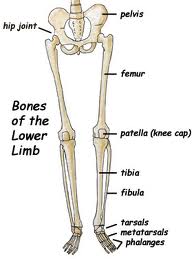
The femur, or thighbone, is the longest and largest bone in the human body. At its top, it creates the ball-and-socket joint of the hip; it lower end helps creates the knee joint. The second largest bone in body is the tibia, also called the shinbone. This long bone connects with the knee at one end and the ankle at the other. Next to the tibia is the fibula, the thinner, weaker bone of the lower leg. It is also known as the calf bone, as it sits slightly behind the tibia on the outside of the leg. The fibula is connected via ligaments to the two ends of the tibia. The patella, commonly known as the kneecap, is at the center of the knee. It aids in knee extension and protects the joint. As the knee bends, the patella slides along a groove in the femur. Below the tibia and fibula are seven bones known as the tarsals. These make up the ankle and upper portion of the foot. The seven tarsal bones are:
Aidan Raftery
Sports Therapist
- Calcaneus: The largest bone of the foot, it is commonly referred to as the heel of the foot.
- Talus: This bone creates the lower portion of the ankle joint.
- Cuboid: This multisurface bone sits on the outside of the foot near the fifth phalange (little toe).
- Cuneiforms: These three small bones are closest to the five metatarsal bones. They sit in a row beginning at the inside of the foot and end at the cuboid.
- Navicular: This curved bone sits between the talus and cuneiforms.
Aidan Raftery
Sports Therapist
 RSS Feed
RSS Feed
